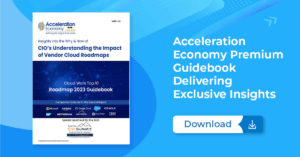
In a recent interview, David O’Neill from APImetrics and I explored the ever-increasing expectations surrounding application programming interface (API) performance and uptime, as well as emerging trends in cloud hosting. In 2022, APImetrics made over one billion calls to 8,400 unique API endpoints across 70 globally distributed data centers and released its results in a study. Naturally, there is a lot to unpack.
Below, I’ll delve into key insights from the APImetrics study and my conversation with O’Neill. I’ll discuss the challenges API providers now face, especially those in jurisdictions and industries mandating certain service-level agreements (SLAs), underscore the importance of cloud hosting choices. I’ll also consider the rising expectations for API uptime and reliability.
Importance of Cloud Hosting Choices
One of the critical factors impacting API performance is the cloud host. O’Neill emphasizes the fundamental problem of heavy reliance on a single cloud provider, particularly AWS East in Virginia. As O’Neill points out, “the further you get away from AWS in Virginia, the worse your performance becomes.”
This dependency poses risks, especially for government services often deployed solely on AWS East for security reasons. On the other hand, hosting on Azure while calling from AWS can result in better performance for specific use cases. To optimize performance, O’Neill recommends organizations verify whether their chosen cloud host aligns with their API’s requirements.
Furthermore, O’Neill warns that not all regions have equivalent cloud infrastructure. African regions, for example, suffer from poor cloud performance due to bad backbones, making it preferable to host APIs elsewhere. He also stresses that organizations must pay attention to content delivery network (CDN) configuration, as a misconfigured CDN can significantly impact API performance.
Rising Expectations for API Uptime and Reliability
Over the years, API uptime and reliability expectations have slowly risen. The APImetrics study found six APIs achieving 99.99% (“four nines”) service availability, which equates to about an hour of downtime per year. Even so, around 30% of providers do not have good Cloud API Service Consistency (CASC) scores across all their APIs. O’Neill estimates that API providers face two times more effort dealing with poor-performing APIs compared to good ones, underscoring the need to continually improve performance rates.
To put things in another perspective, poor reliability doesn’t even make it into the top 10 obstacles to consuming APIs — lack of documentation and poor discoverability are number one and two, respectively, in Postman’s “2023 State of the API Report.” This shows that high availability for web APIs is an expectation in this day and age.
For example, consider the top performer of 2022, PagerDuty. In 2022, the service had only 21.9 minutes of measurable downtime. It boasted a pass rate of 100.00%, with a 781ms median total time. Calls from AWS North America tended to perform the best, at 361ms. The APImetrics API Directory names a handful of other cloud services, including Open Weather, Mux API, Google Search API, and Box API, as top performers.
API Performance Can Affect The Bottom Line
O’Neill says API performance is not just a DevOps issue but is increasingly becoming an API product management challenge. For instance, as businesses seek to monetize their APIs, they must continue to drive consistent value to their customers. Focusing on API monetization without considering performance can lead to bad business decisions and broken service-level agreements.
Since APIs are now at the forefront of digital business, incidents are increasing, underscoring the need to track API performance and ensure bottlenecks don’t harm customer experience. Companies need to focus on delivering APIs that work well for end users, and this requires a shift in mindset and attention to detail rather than just the cash spent on development.
Governance and Regulation in the API Space
With the increasing importance of APIs, governance and regulation are crucial. O’Neill says API metrics are evolving to support API governance, especially in the context of open banking.
In Europe, for example, open banking regulations have made it essential for financial institutions to provide API-driven data and functionality to third-party providers or FinTechs. Global banking standards have also emerged in other territories, including Mexico, Brazil, and Australia.
In addition to verifying internal APIs are up to code, regulators are increasingly interested in verifying third-party APIs for availability and uptime. However, measuring API performance can be problematic due to the varying perspectives and moving parts within APIs, notes O’Neill. In response, it’s becoming more common for companies to build directories and custom dashboards to monitor the SLAs of APIs they use, emphasizing the need for a holistic approach to API performance measurement.
Adapting APIs to the Shifting Cloud Landscape
In conclusion, the expectations for APIs and cloud performance are undeniably rising, and businesses must adapt to this shifting landscape. Cloud hosting choices, API uptime, and reliability are all critical factors in providing a seamless digital experience for customers. With the increasing focus on API governance and regulation, companies need to prove the functionality of their APIs to meet industry standards and ensure compliance.
As the digital world continues evolving, API providers must prioritize performance, mitigate security risks, and ensure a positive overall user experience to thrive in an ever-competitive landscape. For more specific details on API performance metrics, I recommend checking out APImetrics’ “The Cloud for APIs: 2022 In Review” and API Directory, which can shed more light on the precise performance expectations surrounding web APIs today.
Gain insight into the way Bob Evans builds and updates the Cloud Wars Top 10 ranking, as well as how C-suite executives use the list to inform strategic cloud purchase decisions. That’s available exclusively through the Acceleration Economy Cloud Wars Top 10 Course.







